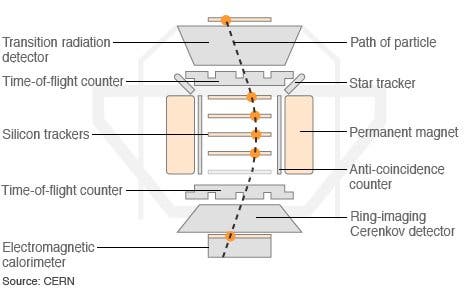Alright, the analogy might not be the best. The Large Hadron Collider is a high energy particle accelerator, while the Alpha Magnetic Spectrometer is a state of the art particle detector, which traps high-energy charged particles called cosmic rays and analyzes them. You see, the AMS can practically perform the same functions as the LHC, only the high energy particles don’t need to be created – they’re harvested from nature, detecting high-energy particles “from the source”, which might eventually lead to tantalizing signs of dark energy or dark matter. In many respects, the AMS is better for science than the LHC, despite both are currently indisputable and dependent from one another.
The Alpha Magnetic Spectrometer, as a project, has been in the works for nearly two decades. After a number of delays, budget cuts and the likes, the seven-tonne giant was launched into space about Endeavour, the last shuttle mission, where it docked with the ISS as module some 18 months ago.
“It took more than 35 missions to build the International Space Station – very complicated space shuttle flights – to construct this incredible laboratory in space,” said Endeavour mission commander Mark Kelly told
“When we installed AMS, that was the last piece of the ISS, then the space station was complete. This is really the pinnacle of the science that ISS will do, in my opinion the most significant experiment we have on board.”
AMS – the pinnacle of space science
In fact the AMS was the last planned part of the International Space Station, making it fully complete after many years and resources invested. Last but not least, that is, as the AMS is the largest and most important experiment in space ever. Since it went into operation, the AMS has so far gathered some 18 billion “cosmic ray”; some of these might hold the key to unraveling the Universe’s mysteries.

Silicon Trackers follow particle paths; how they bend reveals their charge
Permanent Magnet is core component of AMS and makes particles curve
Time-of-flight Counters determine lowest-energy particle velocities
Star Trackers scan star fields to establish AMS’s orientation in space
Cerenkov Detector makes accurate velocity measurements of fast particles
Electromagnetic Calorimeter measures energy of impacting particles
Anti-coincidence Counter filters signal from unwanted side particles
The team has already noted an excess of extremely high-energy positrons – the antimatter equivalent of electrons – and atomic nuclei at 9 teraelectronvolts (TeV) – higher even than the LHC can produce. The scientists involved in the project, however, aren’t too quick on publishing hasty results. The AMS collects hundreds of times per second, and a team of scientists at CERN is constantly monitoring particles 24/7 in shifts. So far, only a few percent of the data has been analyzed.
I have told my collaborators that in the next 40-50 years it is very unlikely people will be so foolish as to repeat this experiment, given the difficulty I ran into,” said Nobel laureate Sam Ting of the Massachusetts Institute of Technology (MIT) has led the project since its inception some 17 years ago.
“Therefore it’s extremely important when we publish a result, we publish it correctly, because otherwise you’ll certainly mislead physics and there’s no way to check us.”
Indeed, news from the AMS should be really interesting to follow in the coming years.
source: BBC






